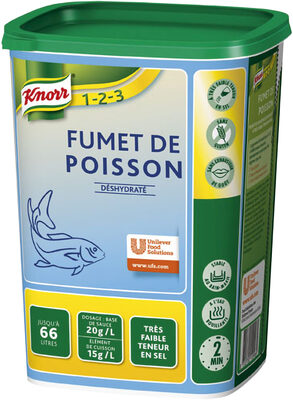Knorr 123 Fumet de Poisson Faible Teneur en Sel 1kg jusqu'à 66L - 1000 g
This product page is not complete. You can help to complete it by editing it and adding more data from the photos we have, or by taking more photos using the app for Android or iPhone/iPad. Thank you!
×
Some of the data for this product has been provided directly by the manufacturer UNILEVER FRANCE RHD.
Barcode: 8722700109969 (EAN / EAN-13)
Common name: Fumet de poisson déshydraté à très faible teneur en sel
Quantity: 1000 g
Packaging: Pot
Brands: Knorr
Categories: Condiments, Sauces, Groceries
Countries where sold: France
Matching with your preferences
Health
Ingredients
Food processing
Additives
Ingredients analysis
Nutrition
Environment
Packaging
Transportation
Other information
Preparation: Disperser la quantité nécessaire de Fumet de poisson Knorr 1-2-3 à très faible teneur en sel dans l'eau bouillante. Laisser mijoter 2 minutes.
Conservation conditions: Bien refermer la boîte après utilisation. A conserver dans un endroit frais et sec. La température de stockage ne doit pas dépasser 25°C.
Customer service: UNILEVER France Food Solutions Relation Consommateurs, Unilever France Food Solutions, 20 rue des Deux Gares 92842 Rueil-Malmaison Cedex
Report a problem
Data sources
The manufacturer UNILEVER FRANCE RHD uses Equadis to automatically transmit data and photos for its products.
Product added on by openfoodfacts-contributors
Last edit of product page on by org-unilever-france-rhd.
Product page also edited by charlesnepote, ecoscore-impact-estimator, kiliweb, packbot, yuka.sY2b0xO6T85zoF3NwEKvllVVbIqAoBflMQzRkHC11vDXCLXVRPRC3dGqL6s.






